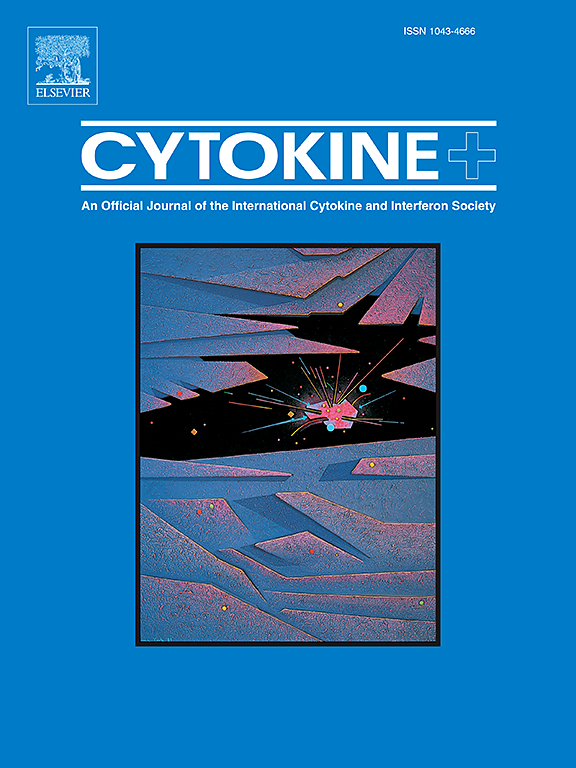Corticosteroid effects on IL-10 and IL-1β in U937-derived macrophages: A model for Kawasaki disease-associated inflammation
IF 3.7
3区 医学
Q2 BIOCHEMISTRY & MOLECULAR BIOLOGY
引用次数: 0
Abstract
Background
Kawasaki disease (KD) is a pediatric vasculitis that has a predilection for coronary artery involvement. Activated macrophages play an important role in the destruction of the coronary arteries in KD. Although intravenous immunoglobulin (IVIG) is standard therapy, corticosteroids are sometimes given to patients at a higher risk of IVIG non-responsiveness. In this study, we examined the effect of IVIG and corticosteroids in U937 derived M1 and M2 a macrophages.
Methods
A total of 40 children with KD and 30 healthy controls were enrolled. U937-derived macrophages were stimulated with patient plasma to examine its effect on macrophage polarization. U937 derived M1 and M2 macrophages were then stimulated with IVIG and methylprednisolone. RNA was extracted from cell cultures and the expression levels of STAT1, interleukin (IL)-1β, PPARγ and IL-10 were determined by RT-PCR.
Results
IVIG was effective at suppressing IL-10 expression in M2 macrophages (relative mRNA expression mean ± SE, high dose IVIG Vs. untreated 0.304 ± 0.095 Vs. 2.541 ± 0.157, p = 0.002), but did not suppress the production of IL-1β in M1 macrophages. In contrast, methylprednisolone both suppressed the IL-1β in M1 macrophages and also enhanced IL-10 in M2 macrophages even at low doses (relative mRNA expression mean ± SE, low dose methylprednisolone Vs. untreated IL-1β 6.353 ± 0.414 Vs. 93.838 ± 1.321, p < 0.001, IL-10 61.117 ± 2.319 Vs. 46.867 ± 2.893, p = 0.005).
Discussion
In this study we found that methylprednisolone was effective at suppressing the inflammatory cytokine IL-1β in M1 macrophages, and enhanced the production of anti-inflammatory IL-10 in M2 macrophages, an effect that could not be produced by IVIG. Our findings provide further mechanistic evidence that corticosteroid therapy, even at low doses may be a cost-effective adjuvant to IVIG therapy in patients with high-risk KD.
皮质类固醇对 U937 衍生巨噬细胞中 IL-10 和 IL-1β 的影响:川崎病相关炎症模型
背景:川崎病(KD)是一种小儿血管炎,好发于冠状动脉。活化的巨噬细胞在 KD 冠状动脉的破坏中起着重要作用。尽管静脉注射免疫球蛋白(IVIG)是标准疗法,但有时也会给对 IVIG 无应答的风险较高的患者使用皮质类固醇。在这项研究中,我们研究了 IVIG 和皮质类固醇对 U937 衍生的 M1 和 M2 巨噬细胞的影响:方法:共招募了 40 名 KD 患儿和 30 名健康对照者。用患者血浆刺激 U937 衍生巨噬细胞,研究其对巨噬细胞极化的影响。然后用 IVIG 和甲基强的松龙刺激 U937 衍生的 M1 和 M2 巨噬细胞。从细胞培养物中提取 RNA,并通过 RT-PCR 测定 STAT1、白细胞介素(IL)-1β、PPARγ 和 IL-10 的表达水平:结果:IVIG能有效抑制M2巨噬细胞中IL-10的表达(相对mRNA表达均值±SE,高剂量IVIG与未处理相比为0.304±0.095与2.541±0.157,p=0.002),但不能抑制M1巨噬细胞中IL-1β的产生。相反,甲基强的松龙既抑制了 M1 巨噬细胞中的 IL-1β,也增强了 M2 巨噬细胞中的 IL-10,即使是低剂量(相对 mRNA 表达平均值 ± SE,低剂量甲基强的松龙与未处理的 IL-1β 6.353 ± 0.414 Vs. 93.838 ± 1.321,p 讨论):在这项研究中,我们发现甲基强的松龙能有效抑制 M1 巨噬细胞中的炎性细胞因子 IL-1β,并增强 M2 巨噬细胞中抗炎性 IL-10 的产生,而 IVIG 无法产生这种效果。我们的研究结果进一步从机理上证明,对于高危 KD 患者来说,皮质类固醇治疗,即使剂量很小,也可能是一种经济有效的 IVIG 辅助治疗方法。
本文章由计算机程序翻译,如有差异,请以英文原文为准。
求助全文
约1分钟内获得全文
求助全文
来源期刊

Cytokine
医学-免疫学
CiteScore
7.60
自引率
2.60%
发文量
262
审稿时长
48 days
期刊介绍:
The journal Cytokine has an open access mirror journal Cytokine: X, sharing the same aims and scope, editorial team, submission system and rigorous peer review.
* Devoted exclusively to the study of the molecular biology, genetics, biochemistry, immunology, genome-wide association studies, pathobiology, diagnostic and clinical applications of all known interleukins, hematopoietic factors, growth factors, cytotoxins, interferons, new cytokines, and chemokines, Cytokine provides comprehensive coverage of cytokines and their mechanisms of actions, 12 times a year by publishing original high quality refereed scientific papers from prominent investigators in both the academic and industrial sectors.
We will publish 3 major types of manuscripts:
1) Original manuscripts describing research results.
2) Basic and clinical reviews describing cytokine actions and regulation.
3) Short commentaries/perspectives on recently published aspects of cytokines, pathogenesis and clinical results.
 求助内容:
求助内容: 应助结果提醒方式:
应助结果提醒方式:


